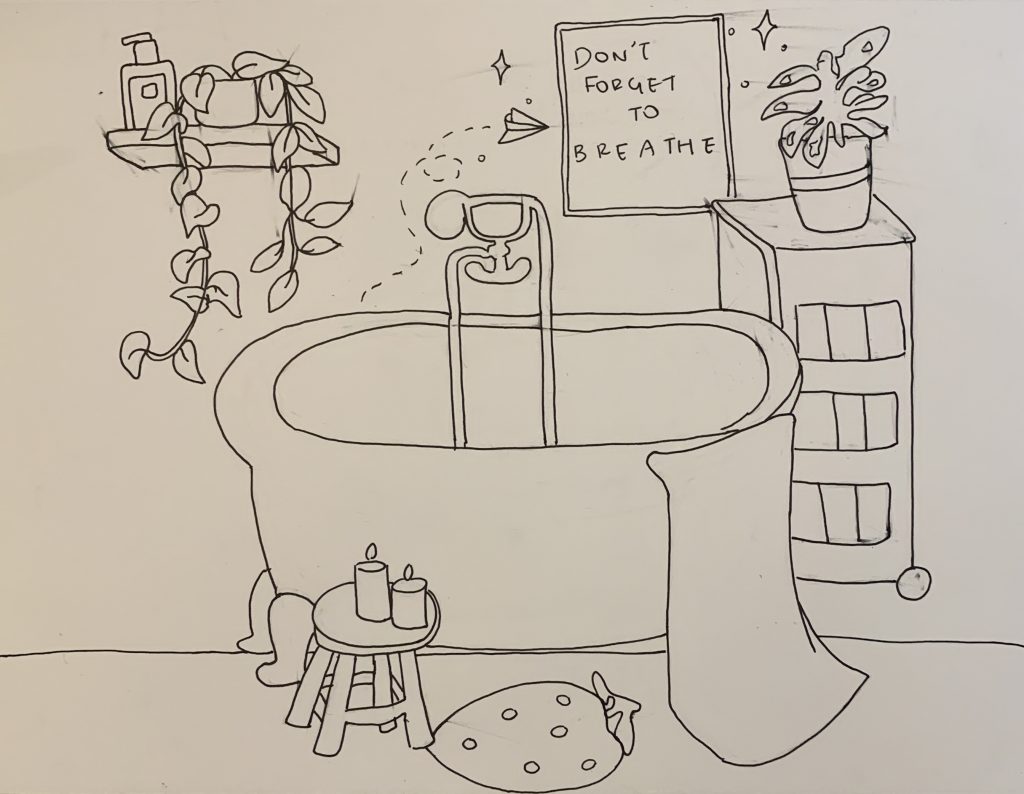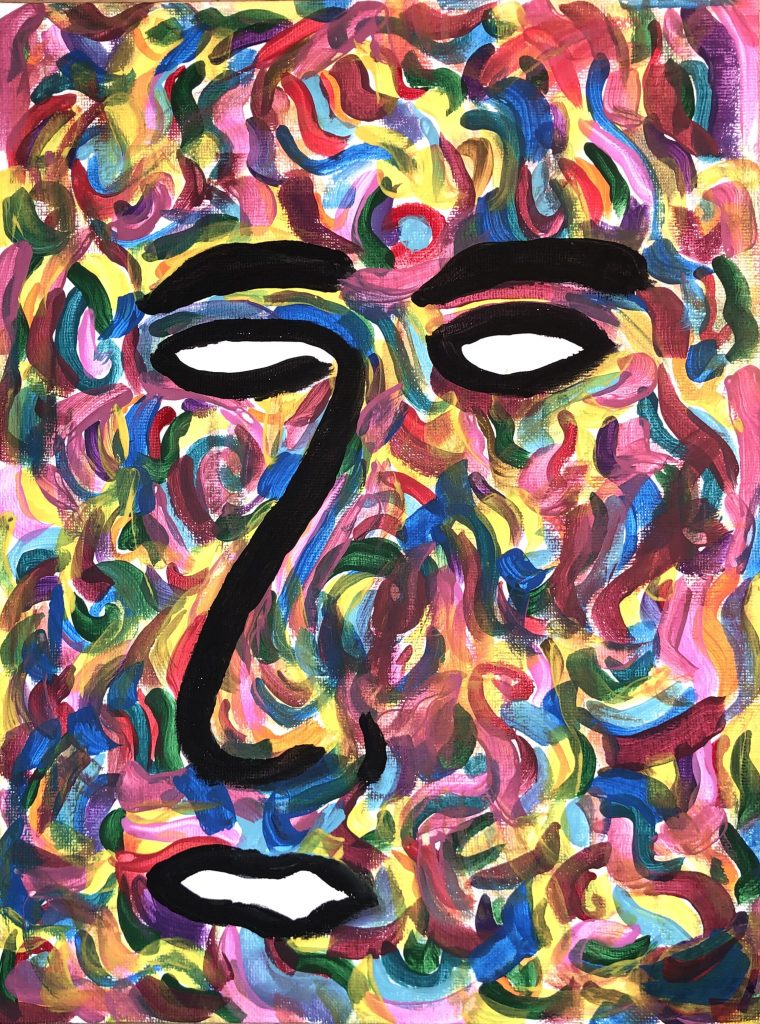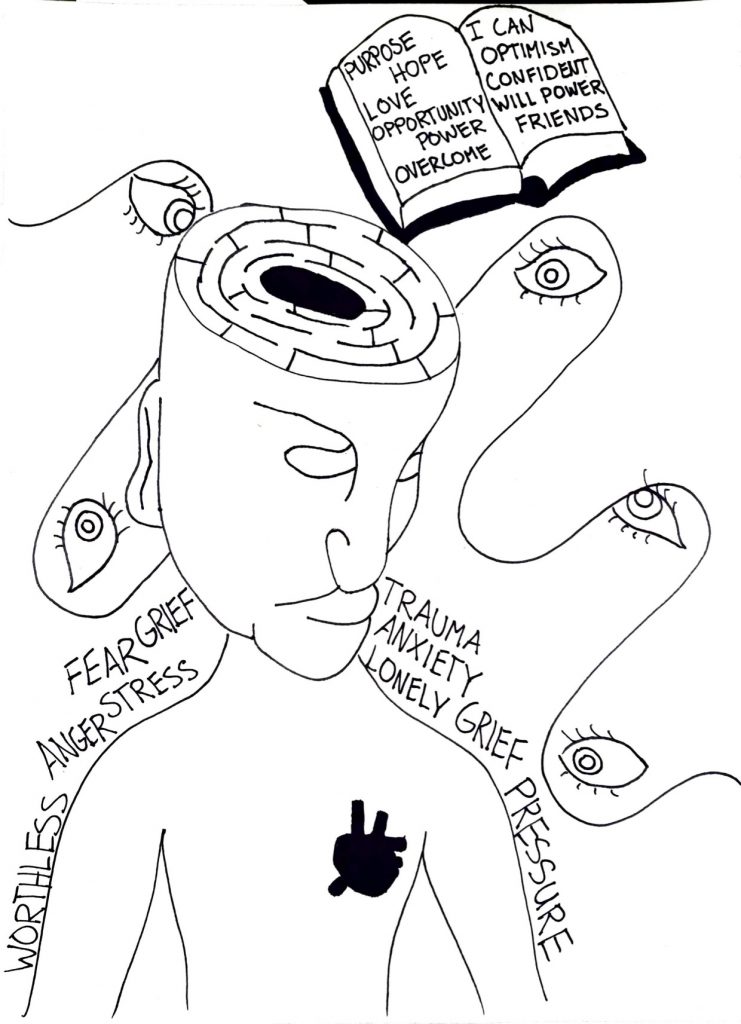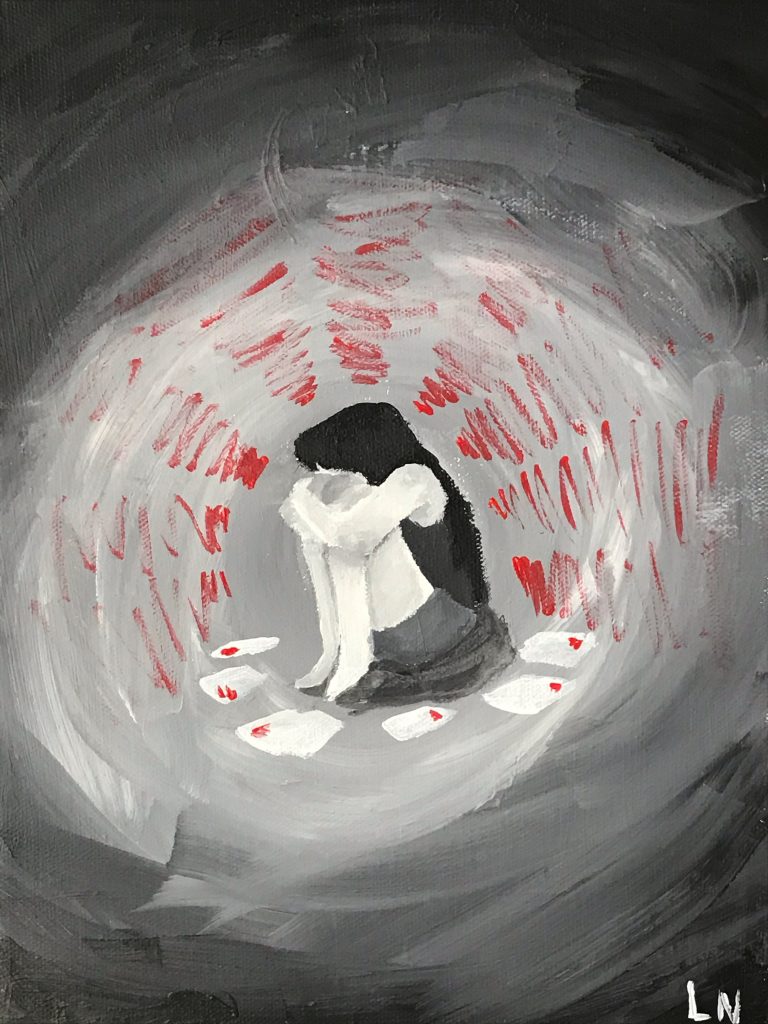Chapter 54: Mental Health
Lumen Learning
“It is only in sorrow bad weather masters us; in joy we face the storm and defy it.”
Mental Health Basics
Knowing how to take care of your mental health when you’re in college is just as important as maintaining your physical health. In fact, there’s a strong link between the two: doctors are finding that positive mental health can actually improve your physical health.
So, what is “mental health?” Mental health can be defined as “a state of well-being in which the individual realizes his or her own abilities, can cope with the normal stresses of life, can work productively and fruitfully, and is able to make a contribution to his or her community.”[1] Having good mental health doesn’t necessarily mean being happy or successful all the time. Most people feel depressed, lonely, or anxious now and then, but those with good mental health can take these feelings in stride and overcome them. When such feelings or moods persist and interfere with a person’s ability to function normally, though, it may be a sign of a more serious mental health problem and time to seek help.
The term mental illness refers to mental disorders or health conditions characterized by “alterations in thinking, mood, or behavior (or some combination thereof) associated with distress and/or impaired functioning.”[2] Depression is the most common type of mental illness, and it affects more than 26 percent of the U.S. adult population. It has been estimated that by the year 2020, depression will be the second leading cause of disability throughout the world, trailing only ischemic heart disease.
Evidence has shown that mental disorders, especially depressive disorders, are strongly linked to the occurrence and course of many chronic diseases—including diabetes, cancer, cardiovascular disease, asthma, and obesity and many risk behaviors for chronic disease, such as physical inactivity, smoking, excessive drinking, and insufficient sleep. In other words, if your mental health is poor, you may be at greater risk for disease and poor physical health.
Mental Health Indicators
In the public health arena, more emphasis and resources have been devoted to screening, diagnosis, and treatment of mental illness than mental health. Little has been done to protect the mental health of those who are free from mental illness. There are some known indicators of mental health, including the following:
- Emotional well-being: life satisfaction, happiness, cheerfulness, peacefulness.
- Psychological well-being: self-acceptance, personal growth including openness to new experiences, optimism, hopefulness, purpose in life, control of one’s environment, spirituality, self-direction, and positive relationships.
- Social well-being: social acceptance, belief in the potential of people and society as a whole, personal self-worth and usefulness to society, and a sense of community.
Former surgeon general David Satcher suggests that there are social determinants of mental health—just as there are social determinants of general health—that need to be in place to support mental health[3]. These include adequate housing, safe neighborhoods, equitable jobs and wages, quality education, and equity in access to quality health care.
There are also some common-sense strategies that you can adopt to support and improve your emotional, psychological, and social health. Not surprisingly, they are very similar to the strategies one uses to cope with stress:
- Eat a balanced diet
- Get enough sleep
- Get regular physical activity
- Stay socially connected with friends and family
- Make smart choices about alcohol and drugs
- Get help if you are anxious or depressed
Depression
Depression is a common but serious mood disorder that’s more than just a feeling of “being down in the dumps” or “blue” for a few days. It causes severe symptoms that affect how you feel, think, and handle daily activities, such as sleeping, eating, or working. To be diagnosed with depression, the symptoms must be present for at least two weeks.
If you have been experiencing some of the following signs and symptoms most of the day, nearly every day, for at least two weeks, you may be suffering from depression:
- Persistent sad, anxious, or “empty” mood
- Feelings of hopelessness, or pessimism
- Irritability
- Feelings of guilt, worthlessness, or helplessness
- Loss of interest or pleasure in hobbies and activities
- Decreased energy or fatigue
- Moving or talking more slowly
- Feeling restless or having trouble sitting still
- Difficulty concentrating, remembering, or making decisions
- Difficulty sleeping, early-morning awakening, or oversleeping
- Appetite and/or weight changes
- Thoughts of death or suicide, or suicide attempts
- Aches or pains, headaches, cramps, or digestive problems without a clear physical cause and/or that do not ease even with treatment
Depression is one of the most common mental disorders in the United States. Current research suggests that depression is caused by a combination of genetic, biological, environmental, and psychological factors. It usually starts between the ages of fifteen and thirty, and is much more common in women. Women can also get postpartum depression after the birth of a baby. Some people get seasonal affective disorder in the winter, when there is less natural sunlight. Depression is one part of bipolar disorder.
Depression, even the most severe cases, can be treated. The earlier that treatment can begin, the more effective it is. Depression is usually treated with medications, psychotherapy, or a combination of the two.
There are days that you will feel down, especially when the demands of college get to you. These feelings are normal and will go away. If you are feeling low, try to take a break from the pressures of college and do something you enjoy. Spend time with friends, exercise, read a good book, listen to music, watch a movie, call a friend, talk to your family, or anything else that makes you feel good. If you feel depressed for two weeks, or the feeling keeps coming back, you should talk to a counselor in the health services/center. They see lots of students who are anxious, stressed, or depressed at college.
Loneliness
Most people experience occasional loneliness, and it’s an especially common experience among first-time college students, who find themselves in an unfamiliar environment with a completely new social scene. Loneliness isn’t necessarily about being alone—you can be surrounded by people and still feel alone. It’s the feeling of being alone that counts, along with feeling empty, unwanted, or isolated. In the following Ted Talk, Sherrie Turkle describes how, in this age of near-constant digital “connection,” loneliness is a challenge that faces us all:
Video: Connected, but alone? Sherry Turkle, TED 2012
If you’re feeling lonely, try taking Turkle’s advice and start a conversation with someone. College is a great place to meet new people and develop new and interesting relationships. Others in college are new, just like you, and will welcome the chance to connect with and get to know another classmate. Try joining a campus interest group or club, play a team sport, or just ask another student if they’d like to meet for coffee or to study.
If feelings of loneliness persist, and especially if you also feel depressed, you should get help from a counselor or health services.
Eating Disorders
Eating disorders are mental health illnesses that involve emotional and behavioral disturbance surrounding weight and food issues. The most common are anorexia nervosa, bulimia nervosa, and binge eating disorder. Eating disorders can have life-threatening consequences.
Anorexia nervosa is characterized by self-starvation and extreme weight loss either through restriction or through binge-purging. This may frequently be a result of body dysmorphic disorder (a condition in which someone feels that their body looks differently than it actually does) or a result of other psychiatric complications such as OCD or depression. Starvation can cause harm to vital organs such as the heart and brain, can cause nails, hair, and bones to become brittle, and can make the skin dry and sometimes yellow or covered with soft hair. Menstrual periods can become irregular or stop completely.
People with bulimia nervosa eat large amounts of food (also called bingeing) at least two times a week and then vomit (also called purging) or exercise compulsively. Because many people who “binge and purge” maintain their body weight, they may keep their problem a secret for years. Vomiting can cause loss of important minerals, life-threatening heart arrhythmia (irregular heartbeat), damage to the teeth, and swelling of the throat. Bulimia can also cause irregular menstrual periods.
People who binge without purging also have a disorder called binge eating disorder. This is frequently associated with feelings of loss of control and shame surrounding eating. People who are diagnosed with this disorder tend to gain weight, and many will have all of the consequences of being overweight, including high blood pressure and other cardiac symptoms, diabetes, and musculoskeletal complaints.
If you think you might have an eating disorder, you should go to the student health center or counseling center and get help. Talk with your family and close friends. Going for help and talking to others about your feelings and illness can be very difficult, but it’s the only way that you’re going to get better. Many colleges have treatment programs for these conditions and trained counselors who can relate to people with an eating disorder.
Anxiety Disorders
People with anxiety disorders respond to certain objects or situations with fear and dread. They have physical reactions to those objects, such as a rapid heartbeat and sweating. An anxiety disorder is diagnosed if a person:
- Has an inappropriate response to a situation
- Cannot control the response
- Has an altered way of life due to the anxiety

Anxiety disorders include the following:
Obsessive-compulsive disorder (OCD) is a type of anxiety disorder. If you have OCD, you have repeated, upsetting thoughts called obsessions. You do the same thing over and over again to try to make the thoughts go away. Those repeated actions are called compulsions. Examples of obsessions are a fear of germs or a fear of being hurt. Compulsions include washing your hands, counting, checking on things or cleaning. Untreated, OCD can take over your life. Researchers think brain circuits may not work properly in people who have OCD. It tends to run in families. The symptoms often begin in children or teens. Treatments that combine medicines and therapy are often effective.
Panic disorder is a kind of anxiety disorder that causes panic attacks. Panic attacks are sudden feelings of terror for no reason. You may also feel physical symptoms, such as
- Fast heartbeat
- Chest pain
- Breathing difficulty
- Dizziness
Panic attacks can happen anytime, anywhere and without warning. You may live in fear of another attack and may avoid places where you have had an attack. For some people, fear takes over their lives and they cannot leave their homes.

Panic disorder is more common in women than men. It usually starts when people are young adults. Sometimes it starts when a person is under a lot of stress. Most people get better with treatment. Therapy can show you how to recognize and change your thinking patterns before they lead to panic. Medicines can also help.
A phobia is a strong, irrational fear of something that poses little or no actual danger. There are many specific phobias. Acrophobia is a fear of heights. You may be able to ski the world’s tallest mountains but be unable to go above the fifth floor of an office building. Agoraphobia is a fear of public places, and claustrophobia is a fear of closed-in places. If you become anxious and extremely self-conscious in everyday social situations, you could have a social phobia. Other common phobias involve tunnels, highway driving, water, flying, animals, and blood. People with phobias try to avoid what they are afraid of. If they cannot, they may experience:
- Panic and fear
- Rapid heartbeat
- Shortness of breath
- Trembling
- A strong desire to get away
Treatment helps most people with phobias. Options include medicines, therapy or both.
Post-traumatic stress disorder (PTSD) is a real illness. You can get PTSD after living through or witnessing a traumatic event, such as war, a hurricane, rape, physical abuse, or a bad accident. PTSD makes you feel stressed and afraid after the danger is over. It affects your life and the people around you. PTSD can cause problems like
- Flashbacks, or feeling like the event is happening again
- Trouble sleeping or nightmares
- Feeling alone
- Angry outbursts
- Feeling worried, guilty, or sad
PTSD starts at different times for different people. Signs of PTSD may start soon after a frightening event and then continue. Other people develop new or more severe signs months or even years later. PTSD can happen to anyone, even children.
Medicines can help you feel less afraid and tense. It might take a few weeks for them to work. Talking to a specially trained doctor or counselor also helps many people with PTSD. This is called talk therapy.

Suicidal Behavior
Suicide causes immeasurable pain, suffering, and loss to individuals, families, and communities nationwide. On average, 112 Americans die by suicide each day. Suicide is the second leading cause of death among 15–24-year-olds, and more than 9.4 million adults in the United States had serious thoughts of suicide within the past twelve months. But suicide is preventable, so it’s important to know what to do.

Warning Signs of Suicide
If someone you know is showing one or more of the following behaviors, he or she may be thinking about suicide. Don’t ignore these warning signs. Get help immediately.
- Talking about wanting to die or to kill oneself
- Looking for a way to kill oneself
- Talking about feeling hopeless or having no reason to live
- Talking about feeling trapped or in unbearable pain
- Talking about being a burden to others
- Increasing the use of alcohol or drugs
- Acting anxious or agitated; behaving recklessly
- Sleeping too little or too much
- Withdrawing or feeling isolated
- Showing rage or talking about seeking revenge
- Displaying extreme mood swings
Get Help
If you or someone you know needs help, call the National Suicide Prevention Lifeline at 1.800.273.TALK (8255). Trained crisis workers are available to talk 24 hours a day, 7 days a week.
If you think someone is in immediate danger, do not leave him or her alone—stay there and call 911.
Resources
OK2TALK is a community for young adults struggling with mental health problems. It offers a safe place to talk.
Activity
Objectives
- Identify the difference between occasional negative emotions and more serious mental health issues, such as anxiety disorder or depression
- Explore practices for ensuring mental health and emotional balance in your life
- Identify resources for further information and guidance about mental health issues
Directions
- Watch the following Tedx Talk, featuring college student Jack Park. In this talk, Jack shares his story of living with a mental disorder and revisits some of the ways he found help and hope. He makes the case for seeing mental illness in a new light, so that people can begin to address some of the issues associated with suicide, depression, and other preventable mental disorders.
Video: Shedding Light on Student Depression, Jack Park TEDx Penn
Write a short (1–2 pages) response paper in which you address the following questions: What do you think of Jack’s practice of changing his “to-do” lists into “want-to-do” lists? What does he hope to gain from this shift? Which coping mechanisms does Jack observe his fellow students using to deal with stress and mental health challenges? What does Jack think is the deeper problem? Why, in Jack’s view, is it hard for people to get help for mental health problems in the same way they might seek help for dental problems? Add your own thoughts about the obstacles you think students may face in getting help for mental health issues.
Licenses and Attributions:
CC licensed content, Original:
- Mental Health. Provided by: Lumen Learning. Located at: https://courses.lumenlearning.com/suny-collegesuccess-lumen1/chapter/mental-health/ License: CC BY: Attribution
- A Bath for the Soul by Brenda Thach. License: CC BY: Attribution.
- Emptiness by Avery C. Swain. License: CC BY: Attribution No Derivatives.
- Stress and Mental Health by Sergio Delgado. License: CC BY: Attribution.
- Piling up by Lillium Nobbs. License: CC BY: Attribution.
All rights reserved content:
- Sherry Turkle: Connected, but Alone?. Provided by: TED. Located at: https://youtu.be/t7Xr3AsBEK4?list=PLQdWctT0t4veKqW8rTIQ0XlcS_DoCLrGE. License: All Rights Reserved. License Terms: Standard YouTube license.
- Shedding Light on Student Depression | Jack Park | TEDxPenn. Provided by: Tedx Talks. Located at: https://youtu.be/ur8TZf6HWSs. License: All Rights Reserved. License Terms: Standard YouTube license.
Public domain content:
- Mental Health Basics. Provided by: CDC. Located at: http://www.cdc.gov/mentalhealth/basics.htm. License: Public Domain: No Known Copyright
- College Health. Provided by: National Institutes of Health. Located at: https://www.nlm.nih.gov/medlineplus/collegehealth.html. License: Public Domain: No Known Copyright
Adaptions: Removed images, relocated learning objectives.
- “Mental Health Basics,” Centers for Disease Control and Prevention, 2013, April 22, 2016. ↵
- “Mental Health Basics.” ↵
- Rahn Bailey, “The Social Determinants of Mental Health,” American Journal of Psychiatry 172, no. 9 (September 1, 2015): 913-914. ↵

